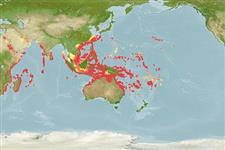Classification / Names
Common names from other countries
Main reference
Size / Weight / Age
Max length : 25.0 cm SL male/unsexed; (Ref. 1602)
Environment
Marine; reef-associated; depth range 3 - 80 m (Ref. 30874), usually ? - 60 m (Ref. 37816)
Climate / Range
Tropical, preferred ?; 30°N - 30°S, 32°E - 163°W
Distribution
Indo-West Pacific: Red Sea and East Africa to Samoa, north to southern Japan and the Ogasawara Islands, south to Australia and Lord Howe Island.
Countries | FAO areas | Ecosystems | Occurrences | Introductions
Short description
Dorsal
spines
(total): 13;
Dorsal
soft rays
(total): 10-11;
Anal
spines: 3;
Anal
soft rays: 6 - 7. Body reddish with 5 dark bars, alternating with thin dark bars in large specimens; median fins with small dark spots; dark spot on cheek (Ref. 4313). Mid-dorsal spines longer than body depth (Ref. 37816).
IUCN Red List Status (Ref. 115185)
Human uses
Fisheries: minor commercial; aquarium: commercial
More information
ReferencesAquacultureAquaculture profileStrainsGeneticsAllele frequenciesHeritabilityDiseasesProcessingMass conversion
Tools
Special reports
Download XML
Internet sources
Estimates of some properties based on models
Phylogenetic diversity index
PD50 = 0.5312 many relatives (e.g. carps) 0.5 - 2.0 few relatives (e.g. lungfishes)
Trophic Level
4.0 ±0.66 se; Based on food items.
Resilience
Medium, minimum population doubling time 1.4 - 4.4 years (Preliminary K or Fecundity.)
Vulnerability
Moderate to high vulnerability (46 of 100)
Price category
